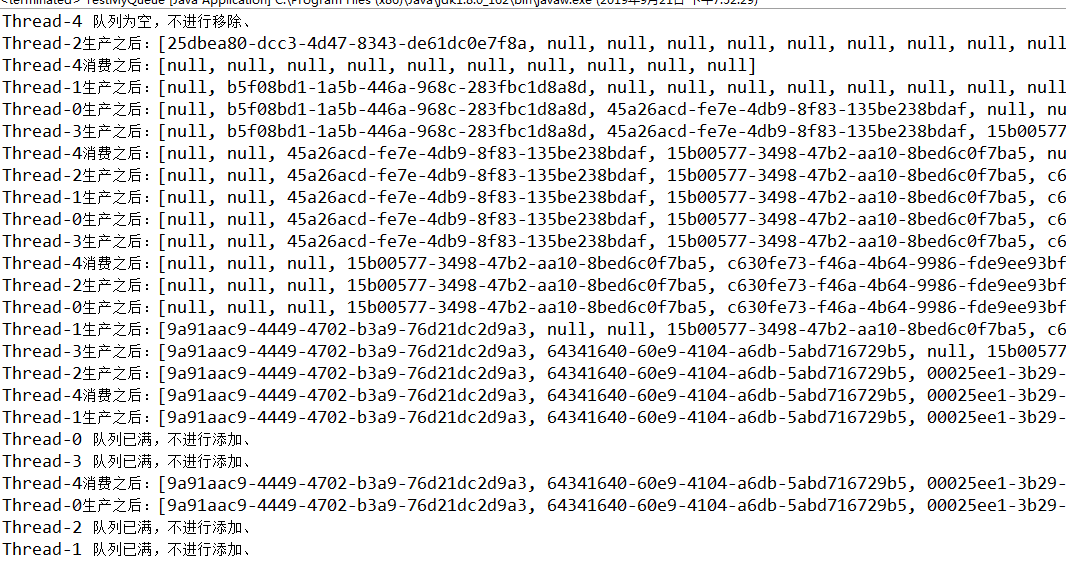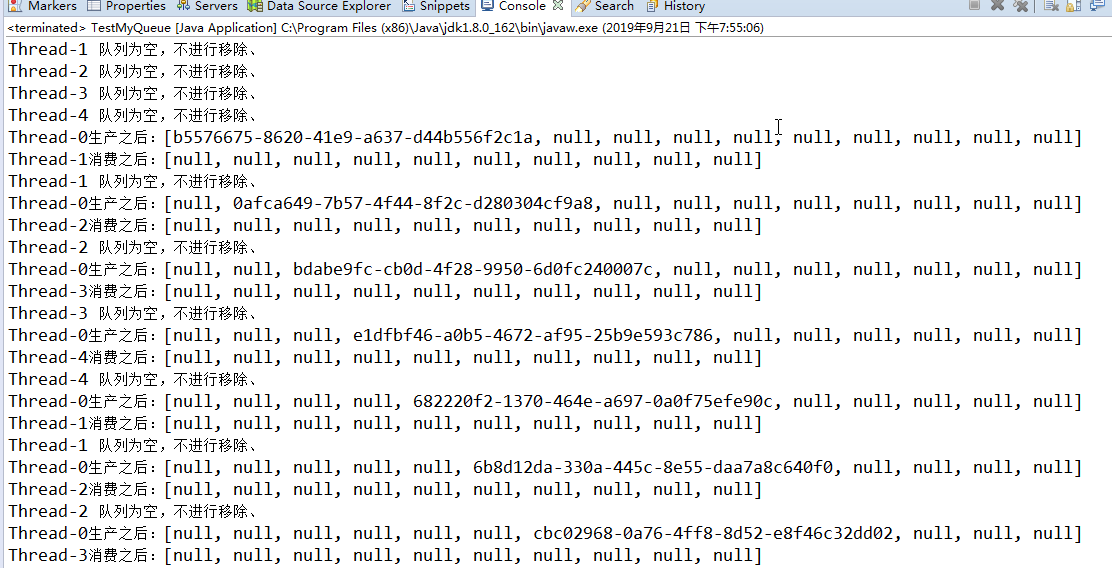上一篇文章介绍了condition的使用方法
https://www.cnblogs.com/liumy/p/11563772.html
这一篇文章介绍如何用condition来实现一个简单的阻塞队列 消费者 生产者模式。
消费者 生产者模式就是 生产者生产某些对象,消费者来消费这些对象。其中用对象数组来保存这些对象,既然是数组,在初始化的时候需要指定数组的大小。
在生产者生产的时候需要检查数组是否已经满了,如果满了,那么生产者会被挂起,等到有消费者消费对象时,再进行生产。
当消费者消费的时候,先检查数组是否为空,如果为空会被挂起,等到生产者生产出对象时,再被唤醒,进行消费,这样就简单实现了一个简单的阻塞队列。
下面 上代码。
MyQueue

package com.citi.test.mutiplethread.demo5; import java.util.Arrays; import java.util.concurrent.locks.Condition; import java.util.concurrent.locks.ReentrantLock; public class MyQueue<E> { public Object[] obj; private int addIndex; private int removeIndex; private int queueSize; private ReentrantLock lock=new ReentrantLock(); private Condition addCondition=lock.newCondition(); private Condition removeCondition=lock.newCondition(); public MyQueue(int count) { obj=new Object[count]; } public Object get(){ return obj[queueSize-1]; } public void add(E e){ lock.lock(); while(queueSize==obj.length){ System.out.println(Thread.currentThread().getName()+" 队列已满,不进行添加、"); try { addCondition.await(); } catch (InterruptedException e1) { // TODO Auto-generated catch block e1.printStackTrace(); } } obj[addIndex]=e; if(++addIndex==obj.length){ addIndex=0; } queueSize++; removeCondition.signal(); System.out.println(Thread.currentThread().getName()+"生产之后:"+Arrays.toString(obj)); lock.unlock(); } public void remove(){ lock.lock(); while(queueSize==0){ System.out.println(Thread.currentThread().getName()+" 队列为空,不进行移除、"); try { removeCondition.await(); } catch (InterruptedException e) { // TODO Auto-generated catch block e.printStackTrace(); } } obj[removeIndex]=null; if(++removeIndex==obj.length){ removeIndex=0; } queueSize--; addCondition.signal(); System.out.println(Thread.currentThread().getName()+"消费之后:"+Arrays.toString(obj)); lock.unlock(); } }
MyQueueAdd 生产者

package com.citi.test.mutiplethread.demo5; import java.util.UUID; public class MyQueueAdd implements Runnable { private MyQueue<String> queue; public MyQueueAdd(MyQueue<String> queue) { this.queue=queue; } @Override public void run() { while(true){ queue.add(UUID.randomUUID().toString()); try { Thread.sleep(1000); } catch (InterruptedException e) { // TODO Auto-generated catch block e.printStackTrace(); } // System.out.println(Thread.currentThread().getName()+":生产者添加元素"+Arrays.toString(queue.obj)); } } }
MyQueueRemove 消费者

package com.citi.test.mutiplethread.demo5; public class MyQueueRemove implements Runnable { private MyQueue<String> queue; public MyQueueRemove(MyQueue<String> queue) { this.queue = queue; } @Override public void run() { while(true){ queue.remove(); try { Thread.sleep(1000); } catch (InterruptedException e) { // TODO Auto-generated catch block e.printStackTrace(); } // System.out.println(Thread.currentThread().getName()+":消费者删除:"+Arrays.toString(queue.obj)); } } }
TestMyQueue 测试类 生产者大于消费者

package com.citi.test.mutiplethread.demo5; public class TestMyQueue { public static void main(String[] args) { MyQueue<String> queue=new MyQueue<String>(10); MyQueueAdd add=new MyQueueAdd(queue); MyQueueRemove remove=new MyQueueRemove(queue); new Thread(add).start(); new Thread(add).start(); new Thread(add).start(); new Thread(add).start(); new Thread(remove).start(); } }
下面是执行结果,可以看到当队列为空时,消费者会被挂起,直到有生产者生产出对象,唤醒消费者,消费者再进行消费。因为生产者的个数大于消费者的个数,所以等到数组满了之后,出现队列已满,不进行添加。

下面将消费者的个数大于生产者的个数
代码

package com.citi.test.mutiplethread.demo5; public class TestMyQueue { public static void main(String[] args) { MyQueue<String> queue=new MyQueue<String>(10); MyQueueAdd add=new MyQueueAdd(queue); MyQueueRemove remove=new MyQueueRemove(queue); new Thread(add).start(); new Thread(remove).start(); new Thread(remove).start(); new Thread(remove).start(); new Thread(remove).start(); } }
下面是执行结果。

